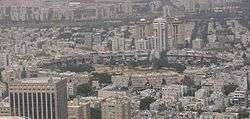Kikar Hamedina

Kikar Hamedina (English: "State Square"), is the largest plaza in Tel Aviv.
Around the plaza, which was designed by architect Oscar Niemeyer (in cooperation with Israeli architects who planned for the existing residential buildings), there is a circular street, He Be'Iyar Street (Israeli Independence Day Street), connecting with two major streets: the north–south Weizmann Street, and the east–west Jabotinsky Street, as well as a number of small streets. The square itself is currently the site of a large, poorly maintained park, however various plans to demolish it and build large shopping centres and luxury towers have faltered due to local opposition.
In the 1960s, circuses moved into the sandy square coming to perform. In the early 1970s extensive construction activity began around He BeIyar Street, which established a uniform design and luxury buildings. Many of these buildings have luxury stores and international designer shops located on the first floor, which have made it one of the most expensive areas in Tel Aviv.
On 3 September, 2011, Kikar Hamedina was the gathering place for the 'March of the Million', the culminating demonstration of the 2011 Israeli social justice protests. The demonstration was the largest in Israel's history, with approximately 300,000 people marching on the square, and 100,000 demonstrating in other locations across Israel.[1]
In November 2015, a plan to revitalize the square was approved. Under the plan, three 40-floor apartment buildings, a 10-acre public park that will take up about half of the square, and an underground car park will be built.[2]
The square is located near the "wine press Garden", an Hellenistic archaeological site in Israel.
The city's English language radio station, TLV1, is based at studios at Kikar Hamedina.
References
| Wikimedia Commons has media related to HaMedina Square. |
Coordinates: 32°05′12″N 34°47′23″E / 32.08667°N 34.78972°E